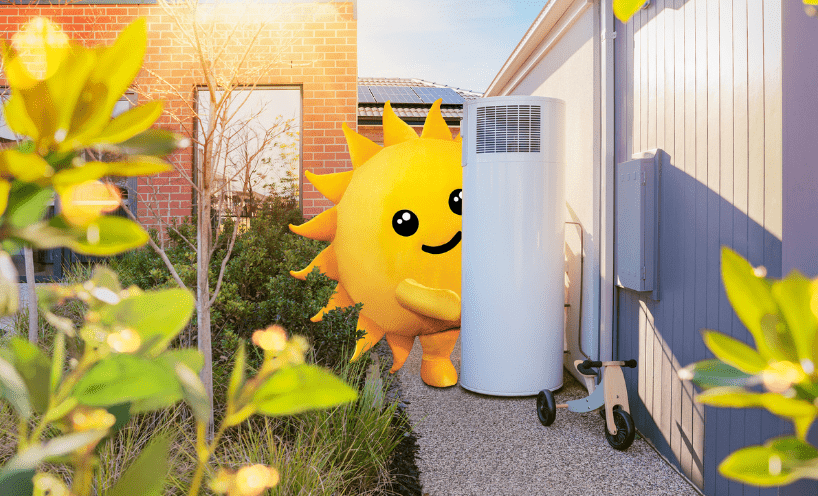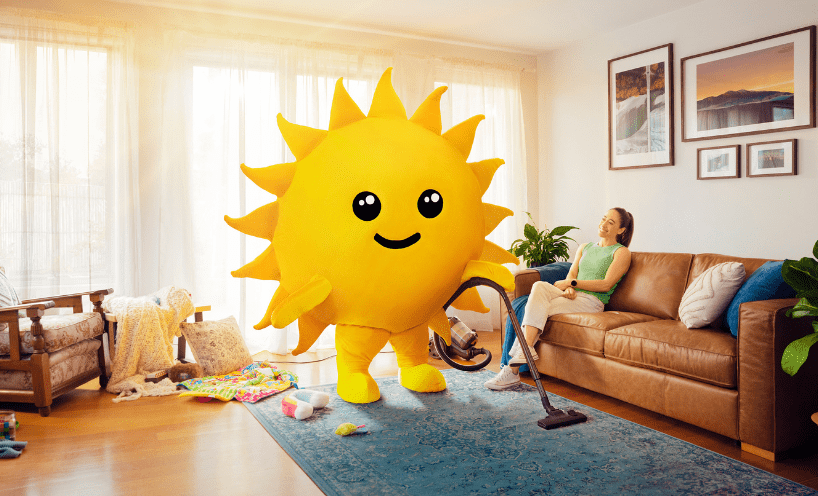In this section we discuss the two main types of efficient hot water system to help you decide which best suits your needs. Look here for further detail: Planning a solar hot water system and Planning a heat pump hot water system.
What is a heat pump hot water system and how does it work?
Air conditioners and refrigerators are two common forms of heat pumps that you might be familiar with. They work by moving or ‘pumping’ heat from one medium to another. For example, your fridge extracts heat from its freezer section and pumps warm air out the back.
A heat pump hot water system includes a heat pump unit, like the outdoor unit for a split-system air conditioner, and a storage tank. The heat pump extracts heat from the air and pumps it into the water storage tank. Good heat pumps can do this effectively even in freezing weather.
Heat pump hot water systems are much more efficient than standard electric water heaters, although the electricity for the unit is still supplied via your normal household electricity wiring or your solar panels.
What is a solar hot water system and how does it work?
A solar hot water system uses heat directly from the sun to heat water. A typical system consists of a hot water storage tank connected via pipework to solar collector panels or evacuated tubes, which heat the water for the tank. Both system types are usually placed on a north-facing roof, although a west-facing roof can also work well in many cases.
As the sun shines on a collector panel, the water in the pipes inside the collector becomes hot. This heated water is circulated up the collector and out through a pipe to the storage tank. Cooler water from the bottom of the tank is then returned to the bottom of the collector, replacing the warmer water.
Deciding between a solar or heat pump hot water system
Consider the environmental benefits of a system, how a water heater works with the existing power supply, the upfront cost and the cost to run, along with other factors such as reliability.
Differences between heat pump and solar hot water systems
Each type of system has advantages and disadvantages:
Choosing a reliable hot water system
When you choose a hot water system, you want a reliable unit that will last.
Solar hot water systems have complex installation requirements, so it’s crucial that you use a highly experienced and accredited installer.
Heat pumps are more complex internally, so a quality design and manufactured product will be important. Talk to your retailer about a trusted brand and model.
Whichever type of system you choose, a trusted installer and a reputable brand and model will reduce the likelihood of problems down the track. Make sure you also check warranty details.
Make sure you do your homework early, before a cold shower forces a snap decision!
How can I make the most or improve of my current system?
The simplest option may be to improve the efficiency of an existing system rather than buy a new one. Improvements can include:
- If you haven't already done so, install low-flow shower heads and aerating taps to reduce hot water requirements
- Check that the hot water pipes are properly insulated (to reduce heat loss) and improve the insulation where necessary
- If you have a storage hot water system (i.e. with a tank):
- Add a Valve Cosy to insulate the pressure and temperature relief valve (valvecosy.com.au)
- Add a tank blanket or other insulation to your water tank
- Adjust the tank’s temperature control to reduce tank temperature if it’s set too high, noting that it should not be less than 60°C for biosafety reasons (to prevent the growth of Legionella bacteria). Some tanks require an electrician to check and adjust temperature
This advice can even improve the performance of new systems.
Updated



